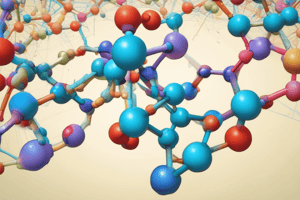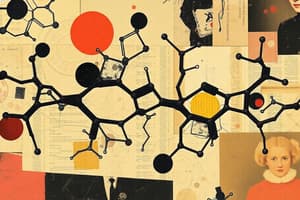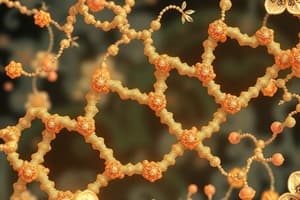Podcast
Questions and Answers
What is the ionized form of the carboxylic acid group in amino acids at physiological pH?
What is the ionized form of the carboxylic acid group in amino acids at physiological pH?
- −COOH
- −COO+
- −COO2−
- −COO− (correct)
Which statement best describes zwitterions?
Which statement best describes zwitterions?
- They are amino acids that do not ionize.
- They are amino acids with only a positive charge.
- They have both positive and negative charges, resulting in an overall zero charge. (correct)
- They are exclusively present in acidic solutions.
Why are all α-amino acids except glycine chiral?
Why are all α-amino acids except glycine chiral?
- They are attached to four different atoms. (correct)
- They lack an α-carbon.
- They have identical atoms attached to the α-carbon.
- They have a symmetrical structure.
In a Fischer projection of an amino acid, where is the carboxylate group placed?
In a Fischer projection of an amino acid, where is the carboxylate group placed?
For which type of isomer are the only amino acids used in protein incorporation?
For which type of isomer are the only amino acids used in protein incorporation?
Which amino acid group is responsible for the positive charge in ionized amino acids?
Which amino acid group is responsible for the positive charge in ionized amino acids?
What characteristic defines the L isomer of amino acids compared to the D isomer?
What characteristic defines the L isomer of amino acids compared to the D isomer?
How do amino acids typically behave in most body fluids regarding ionization?
How do amino acids typically behave in most body fluids regarding ionization?
What amino acid is at the N-terminal of the tripeptide Gly-Ser-Met?
What amino acid is at the N-terminal of the tripeptide Gly-Ser-Met?
Which bond is primarily formed between amino acids to create a peptide?
Which bond is primarily formed between amino acids to create a peptide?
What is the C-terminal amino acid in the tripeptide Gly-Ser-Met?
What is the C-terminal amino acid in the tripeptide Gly-Ser-Met?
What is the three-letter abbreviation for Serine?
What is the three-letter abbreviation for Serine?
Which of the following sequences correctly represents the order of amino acids in the tripeptide Gly-Ser-Met?
Which of the following sequences correctly represents the order of amino acids in the tripeptide Gly-Ser-Met?
When drawing the peptide bond formation between Valine and Threonine, which group is removed from Valine?
When drawing the peptide bond formation between Valine and Threonine, which group is removed from Valine?
If the dipeptide Val-Pro is constructed, what would be a characteristic feature of the peptide bond formation?
If the dipeptide Val-Pro is constructed, what would be a characteristic feature of the peptide bond formation?
What characterizes nonpolar amino acids?
What characterizes nonpolar amino acids?
What is the condensed structural formula of the tripeptide formed from Glycine, Alanine, and Valine?
What is the condensed structural formula of the tripeptide formed from Glycine, Alanine, and Valine?
Which group of amino acids contains R groups that interact with water?
Which group of amino acids contains R groups that interact with water?
What is the significance of the isoelectric point (pI) in relation to amino acids?
What is the significance of the isoelectric point (pI) in relation to amino acids?
How do polar basic amino acids behave at pH levels higher than their pI?
How do polar basic amino acids behave at pH levels higher than their pI?
Which functional group is featured in polar acidic amino acids?
Which functional group is featured in polar acidic amino acids?
When does an amino acid exist as a positive ion?
When does an amino acid exist as a positive ion?
What kind of R groups do polar neutral amino acids contain?
What kind of R groups do polar neutral amino acids contain?
What happens to amino acids when the surrounding solution becomes more basic than their pI?
What happens to amino acids when the surrounding solution becomes more basic than their pI?
What is the main structural feature of a beta-pleated sheet?
What is the main structural feature of a beta-pleated sheet?
What structural form do beta-amyloid proteins take in a healthy brain?
What structural form do beta-amyloid proteins take in a healthy brain?
What is the composition of collagen fibers?
What is the composition of collagen fibers?
Which of the following describes a protein's tertiary structure?
Which of the following describes a protein's tertiary structure?
In Alzheimer’s disease, what happens to beta-amyloid proteins?
In Alzheimer’s disease, what happens to beta-amyloid proteins?
Which characteristic of collagen contributes to its structural integrity?
Which characteristic of collagen contributes to its structural integrity?
What often distinguishes the brain tissue of Alzheimer's patients?
What often distinguishes the brain tissue of Alzheimer's patients?
What triggers the twisting and bending of a polypeptide chain during tertiary structure formation?
What triggers the twisting and bending of a polypeptide chain during tertiary structure formation?
What is the primary role of myoglobin in skeletal muscle?
What is the primary role of myoglobin in skeletal muscle?
Which type of protein is characterized by a long, thin, fiber-like shape?
Which type of protein is characterized by a long, thin, fiber-like shape?
What characterizes the quaternary structure of a protein?
What characterizes the quaternary structure of a protein?
Which two types of keratins are mentioned as fibrous proteins?
Which two types of keratins are mentioned as fibrous proteins?
How many amino acids are there in the myoglobin protein structure?
How many amino acids are there in the myoglobin protein structure?
What type of bonds primarily stabilizes the secondary structure of proteins?
What type of bonds primarily stabilizes the secondary structure of proteins?
Which of the following is a key feature of hemoglobin?
Which of the following is a key feature of hemoglobin?
Which interaction is crucial for the tertiary structure of proteins?
Which interaction is crucial for the tertiary structure of proteins?
Flashcards
What is a Tripeptide?
What is a Tripeptide?
Three amino acids linked together by peptide bonds.
What is Peptide bond formation?
What is Peptide bond formation?
The process of removing atoms to form a peptide bond between amino acids.
What is a Zwitterion?
What is a Zwitterion?
An amino acid that exists with both positive and negative charges but is overall neutral.
What makes an amino acid chiral?
What makes an amino acid chiral?
Signup and view all the flashcards
What are Nonpolar amino acids?
What are Nonpolar amino acids?
Signup and view all the flashcards
What are Polar amino acids?
What are Polar amino acids?
Signup and view all the flashcards
What is the Primary Structure of a protein?
What is the Primary Structure of a protein?
Signup and view all the flashcards
What is the Secondary Structure of a protein?
What is the Secondary Structure of a protein?
Signup and view all the flashcards
What is the Tertiary Structure of a protein?
What is the Tertiary Structure of a protein?
Signup and view all the flashcards
What is the Quaternary Structure of a protein?
What is the Quaternary Structure of a protein?
Signup and view all the flashcards
What is a β-Pleated Sheet?
What is a β-Pleated Sheet?
Signup and view all the flashcards
What is a Triple Helix?
What is a Triple Helix?
Signup and view all the flashcards
What are Globular Proteins?
What are Globular Proteins?
Signup and view all the flashcards
What are Fibrous Proteins?
What are Fibrous Proteins?
Signup and view all the flashcards
What is Beta-amyloid misfolding in Alzheimer’s?
What is Beta-amyloid misfolding in Alzheimer’s?
Signup and view all the flashcards
What is the Isoelectric Point (pI)?
What is the Isoelectric Point (pI)?
Signup and view all the flashcards
What is required for Hemoglobin functionality?
What is required for Hemoglobin functionality?
Signup and view all the flashcards
Where are Peptide Bonds found?
Where are Peptide Bonds found?
Signup and view all the flashcards
Where are Hydrogen Bonds found?
Where are Hydrogen Bonds found?
Signup and view all the flashcards
Study Notes
Drawing Peptides
- Tripeptides consist of three amino acids linked by peptide bonds.
- For Gly-Ser-Met:
- Remove an oxygen atom from the carboxylate group of Gly (N-terminal).
- Remove two hydrogen atoms from the ammonium group of Ser (adjacent amino acid).
- Connection of amino acids through peptide bonds is essential in forming peptides.
Ionization of Amino Acids
- Amino acids typically exist as zwitterions at physiological pH.
- The amino group (-NH₂) becomes ionized (-NH₃⁺) while the carboxylic acid (-COOH) loses a proton to form (-COO⁻).
- Zwitterions maintain overall neutrality despite having both positive and negative charges.
Amino Acid Stereoisomers
- All α-amino acids except glycine are chiral, with the α-carbon attached to four different atoms.
- Two isomer forms exist: D and L forms, with L being the only form used in proteins.
- Fischer projections can be used to depict the arrangement of amino acids.
Classification of Amino Acids
- Nonpolar amino acids have hydrophobic R groups (e.g., hydrogen, alkyl, or aromatic).
- Polar amino acids are hydrophilic and can be categorized:
- Polar Neutral: Contains -OH, -SH, or -CONH₂ groups.
- Polar Acidic: Contains carboxylate groups.
- Polar Basic: Contains amino groups that can ionize.
Levels of Protein Structure
- Primary Structure: Sequence of amino acids linked by peptide bonds.
- Secondary Structure: Involves hydrogen bonding to form α-helices and β-pleated sheets.
- Tertiary Structure: Three-dimensional shape due to R group interactions, involving folding and twisting.
- Quaternary Structure: Combination of multiple polypeptide chains to form a functional protein (e.g., hemoglobin with two α and two β chains).
Specific Protein Structures
- β-Pleated Sheet: Formed by hydrogen bonds between carbonyl groups and N-H groups of adjacent polypeptide chains.
- Triple Helix: Structure of collagen made from three intertwined polypeptide chains, providing structural strength.
- Globular Proteins: Compact, spherical structures like myoglobin, which store oxygen.
- Fibrous Proteins: Long, fiber-like shapes, involved in structural roles in tissues (e.g., keratins in hair and feathers).
Alzheimer’s Disease
- Characterized by memory loss and difficulties in daily tasks.
- Beta-amyloid proteins normally exist in an α-helical form but misfold into β-pleated sheets in affected individuals, forming insoluble plaques.
Ionized Forms and Isoelectric Point
- Zwitterions form at the isoelectric point (pI); amino acids can exist as positive ions in acidic solutions and as negative ions in basic solutions relative to their pI.
Hemoglobin Functionality
- Hemoglobin's quaternary structure is crucial for transporting oxygen, requiring the proper assembly of its four polypeptide subunits.
Exercise and Application
- Identify structures present in proteins:
- Peptide bonds are found in primary and higher structures.
- Hydrogen bonds are present in secondary (between chains) and tertiary (within chains) structures.
Studying That Suits You
Use AI to generate personalized quizzes and flashcards to suit your learning preferences.



